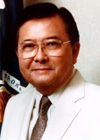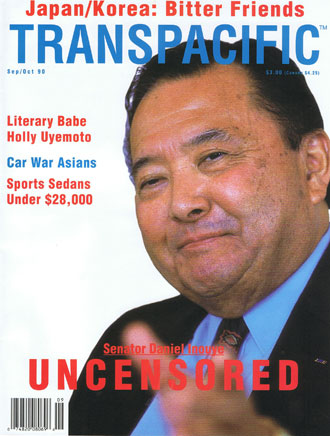|
GOLDSEA |
ASIAMS.NET |
ASIAN AMERICAN PERSONALITIES
THE 130 MOST INSPIRING ASIAN AMERICANS
OF ALL TIME
 Daniel K. Inouye
Daniel K. Inouye
by David Kim
PAGE 1 OF 3
 n a machinegun-raked ridge in Italy, Inouye showed that Japanese Americans were willing to go for broke even in the service of their as-yet-unworthy nation. His right arm was lost on that ridge but the rest of him was obliged to return home to face slurs and racist barbers while completing his patriotic mission as one of America's most powerful senators.
n a machinegun-raked ridge in Italy, Inouye showed that Japanese Americans were willing to go for broke even in the service of their as-yet-unworthy nation. His right arm was lost on that ridge but the rest of him was obliged to return home to face slurs and racist barbers while completing his patriotic mission as one of America's most powerful senators.
Born on September 7, 1924 Daniel Ken Inouye is the seventh in a line of first sons. He grew up in a Japanese ghetto along Queen Emma Street, blissfully oblivious to his family's poverty. When he was not yet five, the family held a great celebration on the occasion of having paid off in full the $400 family debt incurred 30 years earlier. The Inouye family's honor was safe.
Inouye was in his senior year at Honolulu's McKinley High School when Japan bombed Pearl Harbor on December 7, 1941. "Like all Nisei, driven by an insidious sense of guilt," he writes in Journal to Washington, Dan disappeared for the next five days to a first aid station to treat the wounded. He then worked the 6 p.m. to 6 a.m. shift after school. A week after the bombing all Japanese Americans were classified 4-C, undesirable aliens. The months passed slowly.
The following June Daniel graduated and started at the University of Hawaii with the goal of becoming an orthopaedic surgeon. He was a halfback on the University's football team. In early 1943 the commander of UH's ROTC announced that the War Department would take 1,500 Nisei volunteers to form a self-contained combat team. "As soon as his words were out, the room exploded with excited shouts," Inouye would later write in Journey. He and his Nisei classmates "literally ran three miles to the draft board."
Over a thousand Niseis volunteered on the first day alone. Inouye was the first to sign up but was rejected because he was pre-med and his work at the medical aid station was considered essential. He immediately quit his post at the aid station and was the second to last to be accepted. Honor, Inouye recalls, was foremost among his reasons for joining. There was also a sense of youthful adventure and not wanting to be left out.
In March, 1943 18-year-old Inouye became the youngest member of the 442nd Regimental Combat Team. As he left for Camp Shelby near Hattiesberg, Mississippi for a year of training, his mother hid her grief. His father's parting words were, "Do not bring dishonor on our name." "I'll be a good soldier," Inouye replied. "I'll come back a corporal."
Inouye was assigned to E Company, Second Battalion. Initially some of the haole officers grumbled about having to lead "a bunch of Japs" into battle but E Company's C.O., a Captain Ensminger who had attended Honolulu's Roosevelt High, was sympathetic from the start. The pidgin expression "go for broke" became the 442nd's motto during those months of training. By the war's end it was to become an American rallying cry.
This being the first time he was away from his restrictive home, Inouye recalls having a good time. But the training was hard, and the men were all in bed by 9 p.m., totally beat. There was hardly any nightlife. Inouye learned to drink beer and coffee. He was one of the very few without a camera and the only one who didn't know how to drive.
Gambling was a popular pasttime. After figuring out that the house was the only winner, Inouye set up and ran "the biggest crap game" in camp. It became a fabulously profitable operation which he kept up even after the regiment was sent to Europe. Unaware of his large gaming profits, his parents were impressed by the fact that he was sending home two-thirds of his paychecks. But Inouye wasn't one to save money. His winnings went toward treating friends to a good time and having his uniform tailor-made. On weekends he reserved a suite at the Roosevelt Hotel, complete with limousine service. Once, during a furlough in Chicago, Inouye was obliged to wait outside the bars because of his age but footed the bill for his friends' entertainment, including the girls. He was popular, considered "a great fellow".
In May of 1944 the 442nd sailed 29 days for the battlegrounds of Naples, Italy where it joined up with the 100th, another Nisei unit bound for glory. By then Inouye was a buck sergeant. Almost immediately, on June 26 the 442nd was thrown into battle. E Company's Captain Ensminger was the first man killed. Inouye soon found himself the only squad leader in the platoon to be unhit. By the end of the day he was made platoon guide. Throughout July and into August the 442nd pushed the Germans north from Rome along the Arno River. Later that summer they were sent to fight in France's Rhone Valley for several months before being returned to Italy to help finish off the German resistance that led to the Nazi surrender.
PAGE 2
1 |
2 |
3
Back To Main Page
|
|
|
|


Sen. Daniel Inouye appeared on the cover of the Sep/Oct 1990 issue of Transpacific magazine.
|
|
“As soon as his words were out, the room exploded with excited shouts," Inouye would later write in Journey. He and his Nisei classmates "literally ran three miles to the draft board.”
|
CONTACT US
|
ADVERTISING INFO
© 1996-2013 Asian Media Group Inc
No part of the contents of this site may be reproduced without prior written permission.
|
